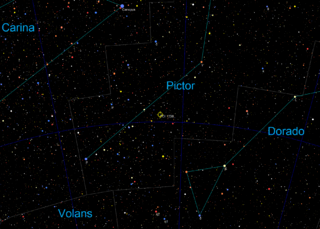TOI-1338 facts for kids
| Observation data Epoch J2000 Equinox J2000 |
|
|---|---|
| Constellation | Pictor |
| Right ascension | 06h 08m 31.968s |
| Declination | -59° 32′ 28.08″ |
| Apparent magnitude (V) | 11.72 |
| Characteristics | |
| Spectral type | F8 / M |
| Variable type | eclipsing |
| Astrometry | |
| Radial velocity (Rv) | 23.56±5.34 km/s |
| Proper motion (μ) | RA: −12.057 mas/yr Dec.: +34.513 mas/yr |
| Parallax (π) | 2.4752 ± 0.0099 mas |
| Distance | 1,318 ± 5 ly (404 ± 2 pc) |
| Orbit | |
| Period (P) | 14.608559+0.00013 −0.00012 d |
| Semi-major axis (a) | 0.1321+0.0024 −0.0025 AU |
| Eccentricity (e) | 0.15603±0.00015 |
| Inclination (i) | 89.696+0.178 −0.114° |
| Semi-amplitude (K1) (primary) |
21.619±0.007 km/s |
| Details | |
| TOI-1338 A | |
| Mass | 1.127+0.068 −0.069 M☉ |
| Radius | 1.331+0.024 −0.026 R☉ |
| Luminosity | 2.1 L☉ |
| Surface gravity (log g) | 4.0 cgs |
| Temperature | 6,160 K |
| Metallicity [Fe/H] | +0.01 dex |
| Rotation | 19±3 d |
| Rotational velocity (v sin i) | 3.6 km/s |
| Age | 4.4 Gyr |
| TOI-1338 B | |
| Mass | 0.3128+0.0113 −0.0118 M☉ |
| Radius | 0.3089+0.0056 −0.0060 R☉ |
| Other designations | |
|
TYC 8533-950-1, EBLM J0608-59, 2MASS J06083197-5932280, RAVE J060832.0-593228
|
|
| Database references | |
| SIMBAD | data |
| Extrasolar Planets Encyclopaedia |
data |
TOI-1338 is a fascinating binary star system located in the Pictor constellation. It's about 1,320 light-years away from Earth. This system is special because it has two known circumbinary planets. These planets orbit both stars at the same time! The first planet, TOI-1338 b, was found by the Transiting Exoplanet Survey Satellite (TESS). The second, BEBOP-1c, was discovered by the Binaries Escorted By Orbiting Planets project.
Contents
How TOI-1338 Was Discovered
The First Planet: TOI-1338 b
The circumbinary planet TOI-1338 b was found in the summer of 2019. A 17-year-old named Wolf Cukier made this amazing discovery. He was a summer intern at the Goddard Space Flight Center at the time.
The name TOI stands for "TESS Objects of Interest." Wolf looked through data from the Planet Hunters project. This project uses volunteers to help scientists. He was searching for data that showed an eclipsing binary. This is when one star passes in front of another, making the light dim. Wolf and six Planet Hunter volunteers helped write the paper about the planet.
The discovery of TOI-1338 b was announced in January 2020. This happened at a big astronomy meeting in Honolulu, Hawaii. Later, in February 2021, some people wanted to rename TOI-1338 b "SOPHIE." This was to honor a Scottish musician named Sophie. Famous singers like Charli XCX and Caroline Polachek supported this idea. The planet's name didn't change, but a small planet (called a minor planet) was later named Sophiexeon.
The Second Planet: BEBOP-1c
In June 2023, scientists announced another planet in the system, named BEBOP-1c. This was a big deal because it was the first circumbinary planet found using a method called radial velocity. This method looks for tiny wobbles in a star's movement caused by a planet's gravity.
The Stars of TOI-1338

TOI-1338 is a binary star system. This means it has two stars orbiting each other. One star is an F8 star, which is similar to our Sun but a bit hotter. The other is a red dwarf, which is much smaller and cooler. The whole system is about 4.4 billion years old.
These two stars orbit each other every 14.6 days. The F8 star is much brighter than the red dwarf. Because of this, it's hard to see the red dwarf's light directly.
The stars' orbit is tilted almost edge-on to us (89.7 degrees). This means we can see them eclipse each other. When the brighter F8 star is partly blocked by the cooler red dwarf, it's called a primary eclipse. The light from the system dims by about 4% for five hours. When the cooler red dwarf is blocked by the hotter F8 star, it's a secondary eclipse. The light dims much less, by less than half a percent, also for about five hours.
The Planets of TOI-1338
The planet TOI-1338 b is bigger than Neptune but smaller than Saturn. It's about 22 times heavier than Earth. Its orbit is very flat, almost perfectly aligned with the orbit of the two stars.
Scientists also measured how the primary star spins. It turns out its spin is also aligned with the orbits of the stars and the planet. This alignment suggests that the planet formed from a single large disk of gas and dust around both stars. This is similar to how planets form around single stars.
BEBOP-1c is a gas giant planet. It's much larger than Earth, weighing about 65 times as much.
Here's a quick look at the planets:
| Companion (in order from star) |
Mass | Semimajor axis (AU) |
Orbital period (days) |
Eccentricity | Inclination | Radius |
|---|---|---|---|---|---|---|
| b | 33.0±20.0 M🜨 | 0.4607+0.0084 −0.0088 |
95.174+0.031 −0.035 |
0.0880+0.0043 −0.0033 |
89.37+0.35 −0.26° |
6.85±0.19 R🜨 |
| c | 65.2+11.8−{{{2}}} M🜨 | 0.794+0.016−{{{2}}} | 215.5+3.3−{{{2}}} | <0.16 | — | — |
See Also
- TOI-700
- TOI-849 b



